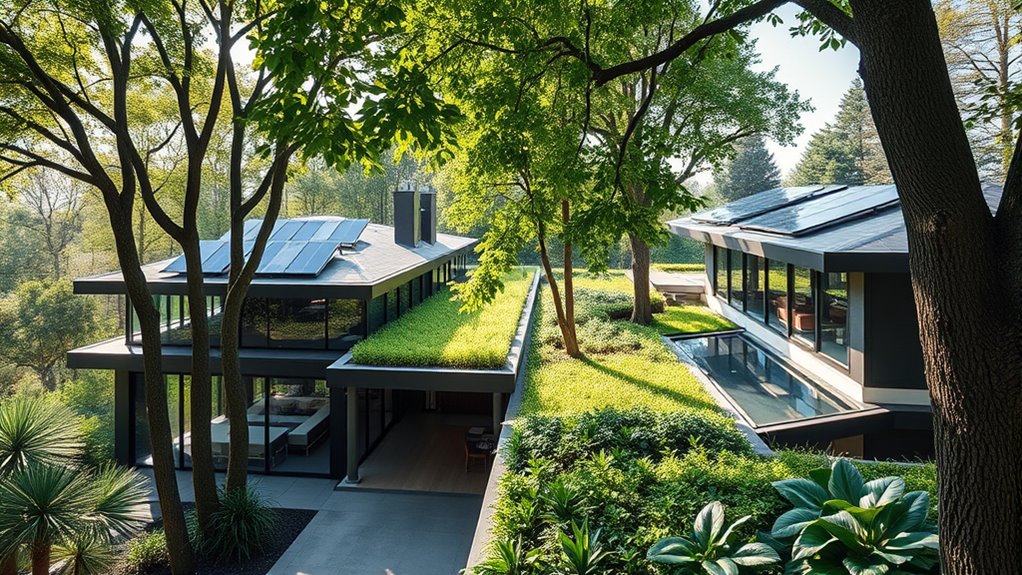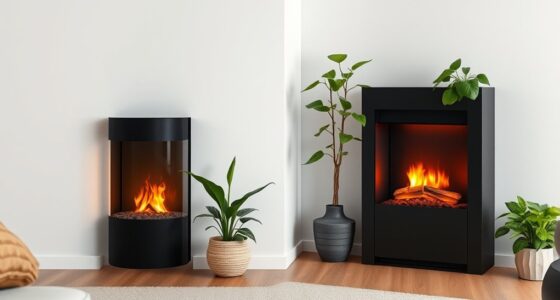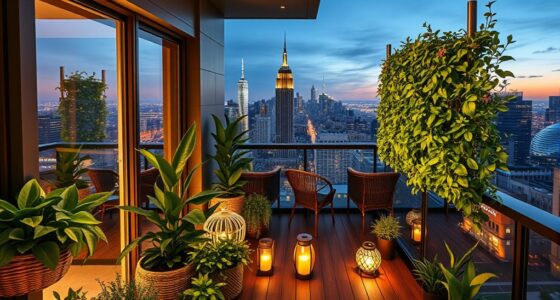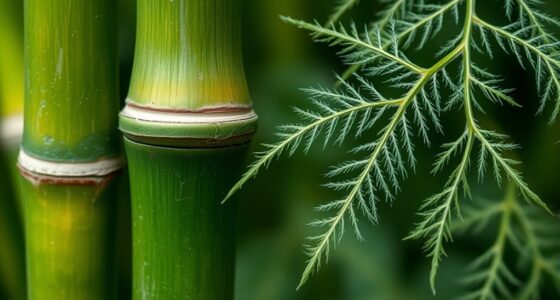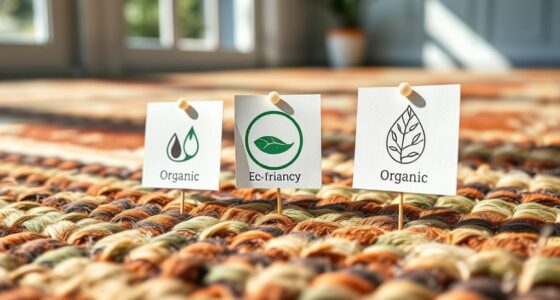Green certification for luxury homes, like LEED and WELL, highlights your commitment to sustainability, health, and elegance. LEED emphasizes energy and water efficiency, sustainable site development, and innovative features like solar panels. WELL focuses on indoor air quality, natural light, and wellness. Achieving these certifications boosts your home’s value and appeal to eco-conscious buyers. Exploring how these standards can transform your luxury residence offers valuable insights into creating an elegant, sustainable living space.
Key Takeaways
- LEED focuses on energy efficiency, water conservation, and sustainable site development to certify environmentally responsible luxury homes.
- WELL emphasizes indoor air quality, natural light, and wellness features to create healthy, comfortable living environments.
- Integrating solar energy and water-efficient systems helps achieve higher certification points and enhances property value.
- Achieving green certification signals luxury homes meet strict sustainability and technological standards, appealing to eco-conscious buyers.
- Combining LEED and WELL standards results in elegant, sustainable, and health-focused living spaces aligned with modern luxury values.
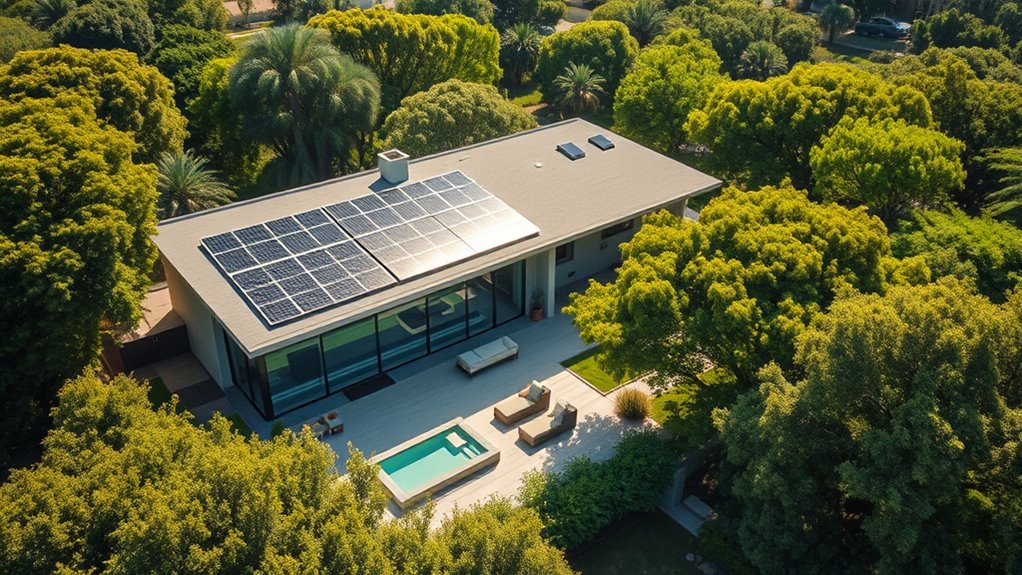
Green certification has become a key factor in the luxury home market, reflecting a growing demand for sustainable living without sacrificing elegance. As a homeowner aiming for excellence, you understand that achieving certification like LEED or WELL not only elevates your property’s status but also brings tangible benefits in energy efficiency and environmental impact. These standards focus on creating sophisticated, eco-friendly spaces that align with your values, especially through innovative features like solar energy systems and water efficiency measures. Incorporating solar panels reduces reliance on fossil fuels, cutting your energy bills and producing clean power that sustains your home’s luxury feel. With solar energy, you don’t just lower costs—you also contribute to a healthier planet, which increasingly matters to discerning buyers. High solar efficiency can significantly boost your home’s certification points and overall sustainability profile.
Achieving green certification elevates luxury homes with sustainable features like solar energy and water efficiency.
Water efficiency is equally *vital* in the certification process. You’ll want your home to be equipped with smart fixtures, rainwater harvesting systems, and drought-resistant landscaping to minimize water waste. These features not only help you meet rigorous standards but also demonstrate your commitment to sustainability. Water-efficient fixtures, such as low-flow toilets and aerated faucets, *substantially* reduce consumption without sacrificing performance or comfort. When combined with water recycling strategies, your home becomes a model of responsible resource management, aligning with the core principles of LEED and WELL certifications.
Understanding the standards means recognizing how they reward thoughtful design and technological integration. For example, LEED emphasizes energy and water efficiency, indoor environmental quality, and sustainable site development. By integrating solar energy, you gain points toward certification while ensuring your home operates at peak efficiency. Water efficiency measures contribute similarly, reducing your environmental footprint and lowering long-term costs. The WELL standard, on the other hand, focuses on health and wellness, ensuring your home’s indoor spaces support your well-being through air quality, natural light, and biophilic design. Combining these approaches creates a luxurious environment that’s not just aesthetically pleasing but also healthy and environmentally responsible.
Achieving green certification elevates your property’s appeal, making it more attractive to eco-conscious buyers and future-proofing your investment. It signals that your home meets high standards for sustainability and innovation, which is especially compelling in the luxury market. By prioritizing solar energy and water efficiency, you’re making strategic choices that benefit both your lifestyle and the planet. Overall, these standards serve as a blueprint for creating a home that’s elegant, efficient, and environmentally sustainable—an ideal balance for the modern luxury homeowner.
Frequently Asked Questions
How Do LEED and WELL Standards Differ in Certification Focus?
LEED and WELL standards differ mainly in their certification focus. LEED emphasizes energy efficiency, sustainable site development, and overall environmental impact, ensuring indoor air quality through eco-friendly practices. WELL, on the other hand, centers on occupant health, comfort, and well-being, focusing on indoor air quality and factors that promote a healthy living environment. You’ll find LEED prioritizes sustainability, while WELL targets the human experience within the space.
What Is the Typical Timeline for Obtaining Green Certification?
Think of the certification process as a journey through a maze—you’ll want to plan your timeline carefully. Typically, it takes 3 to 6 months, depending on project complexity and preparedness. You should allocate time for documentation, inspections, and reviews, ensuring smooth timeline planning. Staying organized and proactive helps you navigate this process efficiently, so you can confidently reach the green certification finish line without unnecessary detours.
Are Green Certifications Mandatory for Luxury Homes?
Green certifications aren’t mandatory for luxury homes, but they are increasingly part of green building trends and luxury eco design. You can choose to pursue LEED or WELL standards to boost your home’s sustainability and appeal. These certifications demonstrate your commitment to eco-friendly practices and can enhance property value. While not required, adopting green certification can set your home apart in the luxury market and align with evolving environmental expectations.
How Do Certification Costs Impact Overall Luxury Home Budgets?
Think of certification costs as seeds planted in your luxury home’s foundation—they symbolize investment in sustainability. These cost implications influence your overall budget planning, requiring you to allocate funds wisely to guarantee quality and compliance. While they may seem high initially, they can boost your home’s value and appeal in the long run. Carefully balancing these expenses helps you create a luxurious, eco-friendly sanctuary without sacrificing financial stability.
Can Existing Luxury Homes Be Retrofitted to Meet LEED or WELL Standards?
Yes, you can retrofit existing luxury homes to meet LEED or WELL standards, but it involves overcoming certification challenges. Focus on a thorough historical renovation to preserve architectural integrity while upgrading systems for energy efficiency and indoor air quality. You’ll need to address structural and design modifications, ensuring compliance with standards. Planning carefully and working with experienced professionals will help you navigate the complexities of retrofitting for green certification.
Conclusion
Achieving green certification for luxury homes is like planting a seed that grows into a thriving, sustainable oasis. It not only enhances your home’s value and comfort but also reduces your environmental impact. By understanding LEED and WELL standards, you’re taking a confident step toward a healthier, more eco-friendly living space. Embrace these certifications as your roadmap for transforming your luxury home into a shining example of sustainability—bright and beautiful, just like a well-tended garden.
